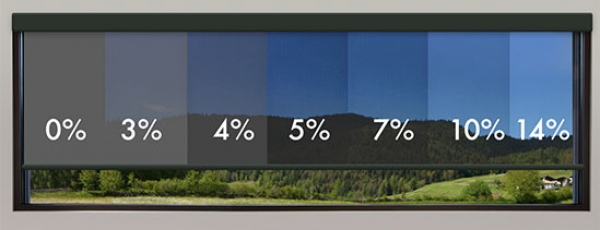Never underestimate the powerful role of window treatments on your comfort, budget, and privacy. Whether you are endeavoring to reduce your energy bill, prevent outsiders from looking inside, or sleep better by letting less morning light in, window treatments are critical to achieving your desired results. But different treatments are suitable for different specific goals, and it’s critical that you understand all your options before you choose. It is thus worthwhile to familiarize yourself with all the features of window treatments, and that begins by understanding the difference between openness and opacity.

Opacity Overview
Opacity describes the way in which drapes, as well as roller, roman, cellular, and pleated shades, filter light. The most common types of opacities, in order from those that filter the least light to those that filter the most, include:
- Sheer- These window treatments are not designed to offer privacy. Instead, their role is to let most of the outdoor light in while preventing a glare. This is ideal for rooms that you want to illuminate as fully as possible through natural lighting, but where you are not particularly worried about outsiders looking in.
- Semi-Sheer- A somewhat more diffuse version of regular sheer windows, these let slightly less light in, but still do not provide privacy.
- Semi-Opaque- A better option for those seeking privacy, these window treatments are often used with drapes or roman and pleated shades. They let enough light in to illuminate the room, but block outsiders from seeing in.
- Room Darkening- Also known simply as “opaque,” these window treatments let in only a modest amount of light through gaps on either side. The gaps vary from half an inch to a quarter inch, depending on the amount of light you want to let in. They offer full, comprehensive privacy, though they also make it harder to illuminate a room with natural light.
- Blackout- The only type of window treatment that lets in even less light than darkening, blackout treatments completely obstruct any outdoor light. Not only does this give you total privacy, but it means that you won’t have to worry about light streaming into your house in the morning and waking you up. This makes them ideal for bedrooms that face the sun.
When choosing opaque window treatments, make sure to take into account energy use. The lower the level of opacity, the less you’ll have to spend on lighting and winter heating, though the more you’ll pay for summer air conditioning. The more strategic your choice, the less energy you could use, lowering both your bills and your environmental footprint.
Openness Overview
Whereas drapes and shades are evaluated in opacity, solar screen window treatments are evaluated in openness. Calculated as the percentage of light that gets through, common openness levels include:
- 3%- 5%- The darkest screen option, this level is ideal if you value privacy but do not want as much natural lighting.
- 5%- 10%- Allowing somewhat more light in, this level makes it marginally easier to see outside, though it should still allow a significant degree of privacy.
- 10%- 14%- This openness level gives you a large degree of sunlight, though it does not offer as much privacy.
- 14%- 20%- The highest openness level, this option is ideal for windows in areas that you want to illuminate fully with natural lighting, but where privacy is not a concern.

All About Blinds & Shutters offers the full range of window treatment options, along with detailed information on how to choose the right treatment for your home. For more information or to to schedule an in-home consultation, visit our website today.



